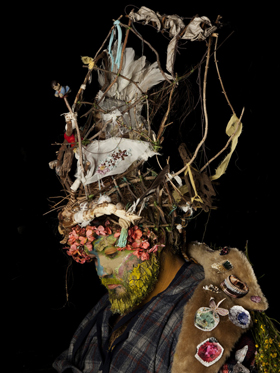Michael Riley in Asia
 One of the joys of touring an exhibition overseas is seeing the familiar in a new light. So it was when I programmed Michael Riley’s photo series Cloud and the film-work Empire into a show called Photographica Australis. Commissioned by the Australia Council it was one of the show-piece exhibitions that complemented the Australian focus of the Spanish art fair ARCO in Madrid. The gallery – a former water tower – consisted of a five-storey cylinder topped by a huge metal sphere and it was here that Michael’s work was presented.
One of the joys of touring an exhibition overseas is seeing the familiar in a new light. So it was when I programmed Michael Riley’s photo series Cloud and the film-work Empire into a show called Photographica Australis. Commissioned by the Australia Council it was one of the show-piece exhibitions that complemented the Australian focus of the Spanish art fair ARCO in Madrid. The gallery – a former water tower – consisted of a five-storey cylinder topped by a huge metal sphere and it was here that Michael’s work was presented.
The response in Madrid was warm and engaged. Visitors sat for long periods under the huge metal dome, which arched overhead like the pre-Copernican heavens, contemplating the images suspended around the space and unfolding on the screens. That positive reception led to inclusion in the Netherlands at the FotoFestival Naarden 2003 and later, through the agency of Asialink in Melbourne, a major tour of four Asian cities.
Presented at the National Gallery of Thailand, the Singapore Art Museum and Taipei Fine Arts Museum the reworked exhibition was given extensive floor space, especially in Singapore and Taiwan where a special galleries were created for the presentation of Michael’s work. The response was overwhelming with more than 140,000 visitors across the four Asian showings. Few if any of the visitors I spoke with knew the history of the Indigenous Peoples of Australia in the past 250 years, but most knew, or had personal experience of other forms of colonisation. Even without the specific historical facts to decode the work, I found visitors were drawn Michael’s work. One woman I spoke with told me she could feel the intensity of the work although she could not interpret it until she read some of the historical information available. But that feeling, that sense of human connectedness, convinced her that the work was speaking to her personally and motivated a strong desire to understand the emotions it evoked.
The other showing in Asia, the third on the itinerary, was the 11th Asian Art Biennale Bangladesh. Taking cultural distinctiveness and globalisation as its theme, this extensive exhibition spread over several palatial halls in Dhaka. It featured work by more than 300 artists from 44 countries in Asia, Africa and the Pacific region, with strong representation from the Middle East. Refreshingly, Australia was considered not as a colonial outpost of the old West but a novel multicultural experiment on the Pacific edge. The Australian works drew enthusiastic attention at the biennial and, again, Michael’s work was found particularly beguiling.
 After several visits and much deliberation by the international panel of judges (from Bangladesh, India, Iran and Turkey) they awarded Cloud and Empire one of three gold medals (the other two going to an installation by a female Iranian media artist and works by a Bangladeshi painter). Their choices signalled a concern that, while it was important to maintain diverse cultural distinctiveness, it was not enough simply to maintain the modes and forms of the past. Speaking on behalf of the judges Gholam Hossein Nami (Iran) said, “Continual imitation and repetition of traditional values will lead to the death of art”. In the work of Michael Riley they found, I believe, a near-perfect synthesis of cultural distinctiveness, awareness of tradition, lively visual language, urgent contemporary content and, perhaps most importantly, human emotional connectedness.
After several visits and much deliberation by the international panel of judges (from Bangladesh, India, Iran and Turkey) they awarded Cloud and Empire one of three gold medals (the other two going to an installation by a female Iranian media artist and works by a Bangladeshi painter). Their choices signalled a concern that, while it was important to maintain diverse cultural distinctiveness, it was not enough simply to maintain the modes and forms of the past. Speaking on behalf of the judges Gholam Hossein Nami (Iran) said, “Continual imitation and repetition of traditional values will lead to the death of art”. In the work of Michael Riley they found, I believe, a near-perfect synthesis of cultural distinctiveness, awareness of tradition, lively visual language, urgent contemporary content and, perhaps most importantly, human emotional connectedness.
___________________________________________________________________________________________________________________________________________________________________________
This essay was first published in Michael Riley: Sights Unseen (National Gallery of Australia 2006) which can be purchased here.
Michael Riley (1960–2004) was an Australian Indigenous photographer and film-maker of Wiradjuri and Gamiloroi heritage. A significant figure in contemporary Australian art and a co-founder of Boomalli Aboriginal Artists Cooperative. His work is held by many public art institutions including the National Gallery of Australia and the Australian Museum.
___________________________________________________________________________________________________________________________________________________________________________
Images:
Upper: Visitors to the 11th Asian Art Biennale view the works in Photographica Australis (photo: © Alasdair Foster)
Lower: Michael Riley (centre) receives his Gold Award from Lieutenant-General M. Harun-Ar-Rashid, High Commissioner for the People’s Republic of Bangladesh (left) with exhibition curator Alasdair Foster. (photo: © Mark Stanley)
~




